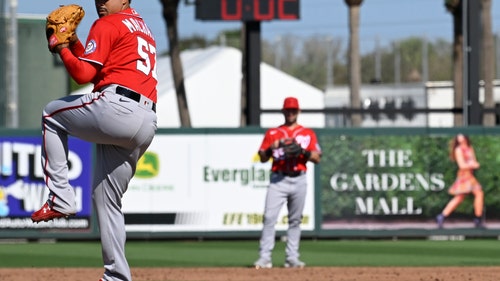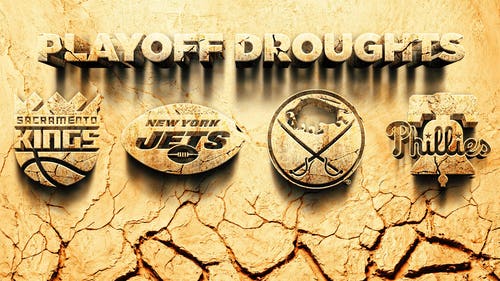
Where are the splash hits for every MLB ballpark?
By Jake Mintz and Jordan Shusterman
FOX Sports MLB Writers
Kerplop. Splish. Splash.
That’s the sound of a home run landing in a body of water. There’s nothing quite like it. It’s good, harmless fun, a dry baseball becoming a drenched dinger. We love to see it.
Last weekend, we were treated to an entire day of splash hits, thanks to the incredible Home Run Derby in Paradise, which features a whole bunch of major-leaguers and prospects launching balls into the water off a beach in the Bahamas.
But unfortunately, there are only a few MLB parks where a true splash hit is realistic. Oracle Park in San Francisco is, of course, the standard, the shining example of a tater taking a dip. There have also been a handful of kerplops from PNC Park in Pittsburgh into the Allegheny River beyond the bleachers in right field. And yes, Chase Field in Arizona has a pool, Tropicana Field in Tampa has a sting ray tank, and Kauffman in Kansas City has fountains, but those are man-made, tacky, forced.
We’re here today to ask the true, brave question: What is the closest splash hit for all 30 MLB parks? How far does a slugger need to drive one out of Fenway to hit water? What distance does a baseball need to travel beyond the friendly confines of Wrigley to reach Lake Michigan? Are there bodies of water anywhere near Dodger Stadium?
We did the work so you don’t have to. We established two primary criteria for eligible splash hits:
- The body of water must be named and must be public. Residential swimming pools in nearby neighborhoods don't cut it.
- The body of water must be in hypothetical fair territory, which makes the orientation of a ballpark crucial. We extended the foul lines infinitely beyond the scope of each ballpark and ensured that any body of water targeted would be a home run. No one cares about a foul-ball splash hit, after all.
To the list! (in order of closest to farthest possible splash)

McCovey Cove in San Francisco became a focal point for splash hits during Barry Bonds' heyday. (Photo by Smith Collection/Gado/Getty Images).
1. Oracle Park (San Francisco Giants)
Body of water: San Francisco Bay
Distance to splash: 360 feet (0.07 miles)
Home of the original splash hit, San Francisco’s McCovey Cove has been the landing spot for more than 140 home runs since the ballpark opened in 200, 35 of which came courtesy of one Barry Lamar Bonds.
The challenge of these splash hits is not the distance but rather getting the ball over the high wall in right field and through the wind that is often coming in off the water. Still, this park is the OG for a reason, as the short distance allows for dozens of other non-Home Run King players to launch balls into the Cove. We’re still waiting for the first right-hander to do it, though.
2. PNC Park (Pittsburgh Pirates)
Body of water: Allegheny River
Distance to splash: 455 feet (0.09 miles)
A splash into the Allegheny is much more difficult than in San Francisco, but it has been done several times, including by Josh Bell twice in one month and, though it’s not fully confirmed because of the camera angles available, the epic Kyle Schwarber blast in the 2015 NL wild-card game. This splash hit cannot be done by just any left-handed slugger; you've gotta have some serious juice.
3. Great American Ballpark (Cincinnati Reds)
Body of water: Ohio River
Distance to splash: 600 feet (0.11 miles)
This has never been done, but unlike with the rest of the home runs on this list, there probably is a world in which an Ohio River splash hit is possible with the right combination of hitter and old BESR aluminum bat. We have been fortunate to witness one close call, though, thanks to Dominican Winter League home run king Juan Francisco’s 502-foot shot in 2011.
Joey Votto came close to clearing the right-field bleachers in September 2021, but even if a batter successfully goes over the seats, it’s another 100 feet or so to the river, so it’d take some really special circumstances.
4. Oakland Coliseum (Oakland Athletics)
Body of water: Lion Creek
Distance to splash: 705 feet (0.13 miles)
It’s nothing special, but we feel pretty confident that this small creek that flows out of the nearby San Leandro Bay along the northern side of the Coliseum should have enough water for a proper splash, assuming the hitter can clear Mount Davis in center field.
5. Tropicana Field (Tampa Bay Rays)
Body of water: Booker Creek
Distance to splash: 757 feet (0.14 miles)
Another type of splash is available inside the dome, with the 10,000-gallon sting ray tank in right-center field, but we’re not counting that. The next obvious question would be: How is a ball going to make it outside if there’s a roof? To that, we respectfully respond: This is a good time in this article to stop concerning ourselves with what’s realistic.
Should a player be able to launch a dinger through the back wall of the Trop — say, teenage Bryce Harper with a metal bat — the creek just outside the ballpark is an excellent splash landing opportunity.
6. American Family Field (Milwaukee Brewers)
Body of water: Menomonee River
Distance to splash: 1,383 feet (0.26 miles)
This is not to be confused with the other river in Wisconsin called the Menominee River, which is more than 100 miles away and in foul territory. We’re not that ambitious.
7. Fenway Park (Boston Red Sox)
Body of water: Muddy River
Distance to splash: 1,508 feet (0.28 miles)
This is a close call, but the Muddy River in deep right field is about 200 feet closer than the much more regal Charles River in deep left field. By the way, in case you’re wondering: It’s about 500 feet to the famous Red Seat but about 5,500 miles to the Red Sea. Now that’d be a splash hit.
8. Citi Field (New York Mets)
Body of water: Flushing Bay
Distance to splash: 1,568 feet (0.28 miles)
He might have 10 Home Run Derby titles to his name when it’s all said and done, but we won’t be impressed with Pete Alonso until he launches one into Flushing Bay.
9. Angel Stadium (Los Angeles Angels)
Body of water: Santa Ana River (when there’s water in it)
Distance to splash: 1,727 feet (0.33 miles)
The possible lack of water was also a point of contention with the L.A. River in relation to Dodger Stadium, but we believe the Santa Ana is splashable enough on the right day, though maybe not all season. The man-made Anaheim Coves are a more consistently available splash alternative to the north, but that’s another mile for our hypothetical homer to travel.
10. Minute Maid Park (Houston Astros)
Body of water: Buffalo Bayou
Distance to splash: 2,043 feet (0.39 miles)
If anything, the Buffalo Bayou is easily the most fun name among all the bodies of water that made this list.
11. Globe Life Field (Texas Rangers)
Body of water: Mark Holtz Lake
Distance to splash: 2,400 feet (0.45 miles)
Named after former Rangers radio broadcaster Mark Holtz, this small lake just to the north of the old stadium is a perfect landing spot for the next dramatic Adolis García dinger — assuming the roof is open, of course.
12. LoanDepot Park (Miami Marlins)
Body of water: Miami River
Distance to splash: 2,419 feet (0.46 miles)
Are we sure that Giancarlo Stanton grand slam off 700-year-old Jamie Moyer wouldn’t have landed in the river if not for that unlucky scoreboard?
13. Busch Stadium (St. Louis Cardinals)

Body of water: Mississippi River
Distance to splash: 2,439 feet (0.46 miles)
A particularly well-struck ball to straight-away center field could go right through the Gateway Arch en route to the Mississippi River.
14. Coors Field (Colorado Rockies)
Body of water: South Platte River
Distance to splash: 2,547 feet (0.48 miles)
We hear it all the time: "The ball flies in Colorado!" OK, well, let’s see it then! It’s just more than 2,500 feet beyond the left-field fence to splash in the South Platte! Is C.J. Cron up for the challenge?
15. Camden Yards (Baltimore Orioles)

Body of water: Inner Harbor
Distance to splash: 3,000 feet (0.56 miles)
This one will require an extremely precise pull job down the right-field line, but a splash into the Inner Harbor would be as Baltimore as it gets. Make it happen, Adley Rutschman.
16. Target Field (Minnesota Twins)
Body of water: Mississippi River
Distance to splash: 3,536 feet (0.67 miles)
The real question here: How long would it take a ball hit into the Mississippi River in Minneapolis by Byron Buxton to float all the way down to St. Louis, where it could pass the ball hit into the Mississippi River by Tyler O’Neill? There’s a good math problem for some sixth graders in the Midwest.
17. Dodger Stadium (Los Angeles Dodgers)
Body of water: Los Angeles River (when there’s water in it)
Distance to splash: 4,568 feet (0.87 miles)
The Los Angeles River can be pretty dry at certain junctures and times of year, but we’ve received assurances from locals that this is an eligible splash landing, especially on the odd chance that it rains a ton:
If you’re unconvinced, another splash is available much deeper in right field: Peanut Lake in Ernest E. Debs Regional Park in Montecito Heights.
18. Wrigley Field (Chicago Cubs)

Body of water: Lake Michigan
Distance to splash: 4,674 feet (0.89 miles)
Forget hitting it onto Waveland or Sheffield — why stop there? The beautiful lake awaits a particularly prodigious Frank Schwindel oppo-taco.
19. Comerica Park (Detroit Tigers)
Body of water: Detroit River
Distance to splash: 4,908 feet (0.93 miles)
The really exciting possibility here is launching one all the way to Canada, which the ballpark orientation allows for.
20. Progressive Field (Cleveland Guardians)
Body of water: Lake Erie
Distance to splash: 5,385 feet (1.02 miles)
This one would land just to the left of the Rock & Roll Hall of Fame. Seems doable for Franmil Reyes.
21. Nationals Park (Washington Nationals)

Body of water: Capitol Reflecting Pool
Distance to splash: 6,230 feet (1.18 miles)
Those familiar with D.C. might be quick to assume that the Anacostia River in deep right field is a more logical choice, but we’re pretty sure that if a right-handed slugger yanked one just down the left line with some serious loft, we could see a splash right in front of the Capitol just barely in fair territory. Or maybe Juan Soto can do it oppo …
22. Chase Field (Arizona Diamondbacks)

Body of water: Koi Pond at the Japanese Friendship Garden of Phoenix
Distance to splash: 6,547 feet (1.24 miles)
Because we aren’t considering indoor splash hits such as one possible with the swimming pool in right-center field, any home run ball with splashing aspirations will have to travel more than a mile northwest to the gorgeous pond at the center of the Japanese Friendship Garden. If landing in such a serene location feels a bit too intrusive, the lagoon at the Enchanted Island Amusement Park another mile to the northwest is a reasonable alternative.
23. Petco Park (San Diego Padres)
Body of water: San Diego Bay
Distance to splash: 7,286 feet (1.38 miles)
The ballpark orientation makes this journey much farther than one might think. In order for it to be a fair ball, a Petco Park splash hit will need to be launched down the left-field line and land just beside the Maritime Museum of San Diego.
24. Truist Park (Atlanta Braves)
Body of water: Chattahoochee River
Distance to splash: 8,078 feet (1.51 miles)
First at-bat back from his ACL injury: Ronald Acuña Jr. into the Chattahoochee. Book it.
25. Guaranteed Rate Field (Chicago White Sox)
Body of water: Lake Michigan
Distance to splash: 8,342 feet (1.58 miles)
The Sox aren't quite as close to a splash as their North Side rivals, but thankfully, the ballpark orientation allows for a similarly satisfying Lake Michigan-bound blast.
26. Citizens Bank Park (Philadelphia Phillies)
Body of water: Delaware River
Distance to splash: 10,296 feet (1.95 miles)
MVP Bryce Harper has done well to ingrain himself in the city of Philadelphia since signing his free-agent mega-deal, but can we consider him a bona fide Philly icon until he hits a dinger into the Delaware? It’s a legitimate question.
27. T-Mobile Park (Seattle Mariners)
Body of water: Lake Washington
Distance to splash: 11,246 feet (2.13 miles)
The orientation of this ballpark keeps the more recognizable Puget Sound in foul territory, so Lake Washington will have to do. Rumor has it Ichiro could have hit balls the requisite two-plus miles to the water if he wanted to. He was more focused on contact, though.
28. Yankee Stadium (New York Yankees)
Body of water: Bronx River
Distance to splash: 11,669 feet (2.21 miles)
The fact that this park is so far down the list is pretty disorienting, but the ballpark orientation is a killer here. Were the ballpark facing directly west instead of east, the Harlem River would be a much more reasonable 1,700-foot target for Aaron Judge or Giancarlo Stanton.
29. Rogers Centre (Toronto Blue Jays)
Body of water: Don River
Distance to splash: 14,256 feet (2.7 miles, or 4.34 kilometers)
In this scenario, the top of the iconic CN Tower that looms over the ballpark would act as an additional right-field foul pole that our four-plus-kilometer dinger would need to stay to the left of.
30. Kauffman Stadium (Kansas City Royals)

Body of water: Blue River (from the Missouri River)
Distance to splash: 24,605 feet (4.66 miles)
There appear to be some smaller, unnamed ponds scattered across the eastern outskirts of Kansas City, but we’re not including those, which means the Royals’ ballpark is officially — and by far — the most difficult in the big leagues from which to achieve an illustrious splash hit.
Perhaps this is why Kauffman Stadium offers arguably the most underrated in-park splash hit in the majors, with the fountains that span nearly the length of the outfield.
Jake Mintz and Jordan Shusterman, creators of the Twitter account Céspedes Family BBQ, write about all things baseball for FOX Sports.










